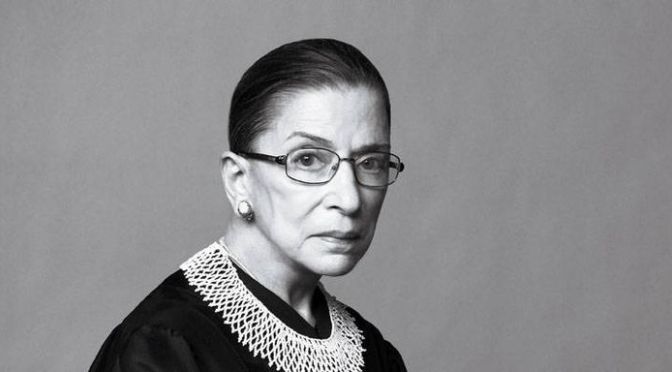Ruth Bader Ginsburg, her Legacy, and what happens next
On Saturday, September 18, 2020, Supreme Court Justice Ruth Bader Ginsburg passed away in her Washington D.C. home surrounded by family. Ginsburg, 87, died due to complications with metastatic pancreatic cancer. Known as a cultural icon to younger generations during her later years. Ruth Bader Ginsburg left a legacy that will be remembered for generations to come.
Ginsburg was one of the 9 women out of 500 people admitted into the Harvard Law School class of 1956. The Dean of the Law School would often ask why the women of Harvard Law School were occupying seats men should have occupied. Although Ginsburg had not entered law school for feminist reaosns, her treatment at Harvard spiked her pursuing of women’s rights. Ginsburg completed her first year of law school at Harvard, but then she transferred to Columbia’s Law School in New York when her husband accepted a job there. Ginsburg graduated from Columbia Law School in 1959 tied as the top in her class with another student; she was the first student to ever attend two top law schools.
After graduating from Columbia Law School, Ginsburg was denied the opportunity to be a clerk for Justice Felix Frankfurter after a Harvard Law professor recommended her. Frankfurter admitted he was not ready to hire a woman clerk, so he requested a male recommendation instead. After applying to 12 law firms and only receiving follow-up interviews from 2 firms, Ginsburg began her law career as a clerk for a United States district court judge named Edmund L. Palmieri. Ginsburg served as Palmieri’s clerk from 1959-1961. After her time with Judge Palmieri, Ginsburg pursued a career in academia despite receiving offers from law firms. Ginsburg worked for the Columbia Law School’s International Procedure Project before becoming a professor at Rutgers Law School in 1963.
At Rutgers Law School, Ginsburg and other women employees fought for an increase in wages due to the wage gap between men and women. At this time, Ginsburg also began working on sex discrimination cases that she was referred to by the American Civil Liberties Union (ACLU) state office in New Jersey. Ginsburg’s handling of sex discrimination led to her co-founding the Women’s Rights Project at the ACLU in 1972. Along with the founding of the Women’s Rights Project, Ginsburg would become the first woman to receive tenure at Columbia Law School when she accepted a position in the same year.
As she led the Women’s Rights Project at the ACLU, Ginsburg would argue 6 cases in front of the Supreme Court. These cases included topics like equality for widows and widowers and the level of judicial scrutiny involved in sex discrimination cases. In the cases Reed v. Reed (1971), Ginsburg would write a brief on behalf of the ACLU arguing that men should not receive preference in being the administrator of estate for deceased people. The rights of pregnant women and sterilization of women were the other major frontiers in which the Women’s Rights Project successfully advocated for during Ginsburg’s time at the ACLU. At the time of her departure from the ACLU, Ginsburg had paved the way for the legal battle of women’s rights.
In 1980, Ginsburg was appointed a Judge of the United States Court of Appeals in Washington D.C. Ginsburg was known to be soft spoken and she valued collegiality with other judges, including conservatives. Ginsburg would serve on the United States Court of Appeals for 13 years before President Clinton nominated her for the Supreme Court in 1993. Ginsburg was confirmed by the Senate in a 96-3 vote. Ginsburg became the second woman to serve as a Supreme Court justice, and the first Democratic Supreme Court nominee since Lyndon Johnson.
During her time as a Supreme Court justice, Ginsburg served as a part of the 4-justice liberal bloc. Whenever Sandra Day O’Connor retired in 2006, Ginsburg remained the only woman justice on the Supreme Court for a few years. Ginsburg referred to this as “the worst time” in an interview. Ginsburg described that when the public entered the Supreme Court’s room, there would be 8 men of a certain size and then a small woman to the side. To Ginsburg, this set a poor image of the Supreme Court. Ginsburg served only a short time as the only woman justice on the Supreme Court. In 2009, Sonia Sotomayor would join the Supreme Court followed by Elana Kagan in 2010. Kagan was appointed to the court due to Justice Paul Stevens retiring. As a result of Stevens retirement, Ginsburg became the leader of the liberal bloc of the Supreme Court in which she was joined by Sotomayor, Kagan, and Breyer. Since there were only four members of the liberal bloc of the Supreme Court, it was known for strong dissents.
Justice Ginsburg often wrote the powerful dissents of the liberal bloc of the Supreme Court since the conservative bloc had the majority in decisions. Her dissents would be what led to Ginsburg becoming a cultural icon in her later years on the Supreme Court. A law student named Shana Knizhnik would nickname Ginsburg the “Notorious R.B.G.”. The image that followed this name included Ginsburg in her judicial robes, a white collar, oversized glasses, and a lopsided crown. The combination of these two things would become a sensation on the Internet, and as a result Ginsburg would become a symbol for feminism.
At the time of her death, Ginsburg is the longest serving woman on the Supreme Court at 27 years. Ginsburg’s death being so close to the 2020 election, there was a dispute across the United States on whether President Trump should get to appoint a third person to the Supreme Court. Ginsburg’s family reported that her final wish was to wait until after the election to fill her seat on the Supreme Court. Another conflicting point involved the handling of Justice Antonin Scalia’s death in 2016 by the Republican-led Senate. Despite Obama being President at the time, Scalia’s seat was kept empty until president-elect Trump took office. Senate Majority Leader Mitch McConnell has been criticized by his opponents for this change in the handling of sudden deaths on the Supreme Court close to elections, but others have praised him in allowing Trump to nominate a third person to the Supreme Court.
On Saturday, September 26, 2020, President Trump announced his intentions of appointing Amy Coney Barrett to the Supreme Court. Barrett has been a judge for the Seventh Circuit Court of Appeals since 2017. Prior to her time as a federal judge, Barrett taught at Notre Dame Law School. Barrett, a devout Catholic, is extremely popular with conservatives especially regarding her views on reproductive rights. However, liberal critics of Barrett argue that she is too involved in her faith to separate her faith from constitutional questions on the Supreme Court. At 48 years old, Barrett could be a member of the Supreme Court for decades to come.
The Senate hearings for Amy Coney Barrett were supposed to begin on Monday, October 12, 2020. However, there is speculation as to whether or not the hearings will proceed on schedule. On October 2, 2020, the White House announced that President Trump and the First Lady tested positive for coronavirus. Due to the Trump Administration interacting with many conservatives this past week regarding Barrett’s nomination, there are a number of Republican legislators testing positive for coronavirus. Two Senators on the Judiciary Committee of the Senate, Thom Tillis (R-NC) and Mike Lee (R-UT) tested positive for coronavirus this week. If more Senators continue to test positive, it is uncertain that the Senate hearings for Barrett’s appointment will happen as planned due to Senators being unable to vote remotely as per Majority Leader McConnell’s rejection of remote voting earlier this year.
If Barrett is confirmed by the Senate, she will become the fifth woman in United States history to become a justice for the Supreme Court. Barrett joining the Supreme Court would allow for a shift to a 6-3 conservative majority on the Supreme Court.





11 Comments
earn paypal money by watching videos
win money video gaming
win money fast
free money
buy domains
buy domains
buy domains
autosurf
buy domains
buy domains
buy domains